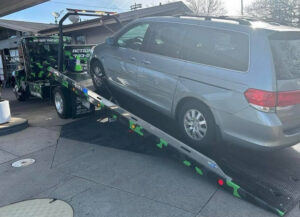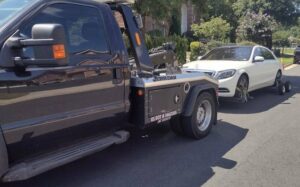 The integral role of tow trucks in law enforcement operations is often overlooked despite their critical importance in managing traffic incidents and ensuring public safety. As traffic congestion and incidents increase, the need for effective Traffic Incident Management (TIM) has become more pronounced. This article explores the collaboration between tow trucks and law enforcement, highlighting their contribution to vehicle impoundment, accident cleanup, and traffic control.
The integral role of tow trucks in law enforcement operations is often overlooked despite their critical importance in managing traffic incidents and ensuring public safety. As traffic congestion and incidents increase, the need for effective Traffic Incident Management (TIM) has become more pronounced. This article explores the collaboration between tow trucks and law enforcement, highlighting their contribution to vehicle impoundment, accident cleanup, and traffic control.
As the first responders in many traffic incident scenarios, law enforcement teams depend heavily on the expertise of tow truck operators to quickly and safely clear accident scenes. This partnership is crucial in mitigating the impact of incidents on the flow of traffic and in reducing secondary accidents, often caused by sudden traffic build-ups and distracted drivers. The fusion of law enforcement capabilities and the technical skills of tow truck operators creates a synergy that is essential to effective Traffic Incident Management. Together, they facilitate rapid response to incidents, ensuring the swift removal of hazards and restoration of normal traffic conditions. This close cooperation is essential not only for efficient incident management but also for the safety of all road users.
Vehicle Impoundment
Tow trucks are essential in law enforcement operations, especially in instances of vehicle impoundment. When a vehicle is parked illegally or is involved in criminal activities, law enforcement relies on tow trucks to remove and transport these vehicles swiftly. This not only helps in maintaining order and safety but also aids in preserving crime scenes, ensuring that valuable evidence is not tampered with.
Expanding Vehicle Impoundment in Law Enforcement
In the context of law enforcement, vehicle impoundment serves multiple strategic purposes. Firstly, it helps in enforcing the law and maintaining order. When a vehicle is parked illegally or used in the commission of a crime, prompt removal is a necessary deterrent and a part of the punitive process. Impoundment also aids in clearing obstructions and restoring the orderly flow of traffic.
Secondly, impounding vehicles involved in criminal activities may lead to significant breakthroughs in investigations. These vehicles often contain crucial evidence that can provide insights into criminal behavior, identify perpetrators, or even expose wider criminal networks. Having tow trucks promptly remove these vehicles ensures this evidence is kept intact and not tampered with, thus preserving the integrity of crime scenes.
Lastly, tow trucks contribute to public safety in situations where a vehicle is abandoned or poses a safety hazard, such as a breakdown on a busy highway. Swift removal prevents potential accidents and disruptions, protecting the community and maintaining roadway efficiency.
The role of tow trucks in vehicle impoundment is therefore not just logistical. It’s an essential part of law enforcement’s toolkit for maintaining public safety, enforcing the law, and facilitating effective criminal investigations.
Accident Cleanup
In the aftermath of road accidents, tow trucks are called upon to clear the scene. They efficiently remove wrecked vehicles and debris, restoring normalcy to the roads as quickly as possible. This rapid response plays a key role in reducing traffic congestion and secondary incidents, ultimately saving lives and resources.
Traffic Control
The presence of tow trucks at accident scenes also aids in traffic control. Their large, visible presence can act as a signaling device, alerting oncoming traffic to the situation ahead. This capability is crucial in preventing further accidents, especially in poor visibility conditions. Moreover, by quickly removing stranded vehicles and obstructions, they help maintain smooth traffic flow, minimizing disruptions to the public’s daily commute.
Collaboration Between Tow Trucks and Law Enforcement
Nonconsensual Towing
Law enforcement agencies frequently rely on tow trucks for the removal of vehicles from public rights-of-way and private property. This process, known as nonconsensual towing, includes both law-enforcement-ordered tows and trespass tows, which involve removing unauthorized vehicles from private property. Policies related to nonconsensual tows are a significant issue in traffic incident management, impacting both public safety and consumer rights (NTIMC – Towing Resources, n.d., “Nonconsensual Towing”).
From the perspective of law enforcement, nonconsensual towing is a crucial tool for maintaining order and safety on the roads. Illegally parked or abandoned vehicles can cause significant disruptions to traffic flow, potentially leading to accidents or other safety hazards. In these scenarios, law enforcement agencies utilize the services of tow trucks to remove the obstruction and restore normal traffic conditions.
It’s important to note that law enforcement officers must follow strict protocols when ordering nonconsensual tows. The officers need to verify that the vehicle is indeed causing an obstruction or is illegally parked before it can be removed. In some jurisdictions, the vehicle owner is given a chance to move their vehicle before it’s towed. If the owner can’t be located or fails to comply, the vehicle is then towed.
Nonconsensual towing is also used during criminal investigations. Vehicles involved in crimes or suspected to contain evidence are often impounded and removed to a secure location. In these cases, the tow truck operators work closely with law enforcement to ensure that potential evidence is preserved and not compromised during the towing process.
Finally, law enforcement also oversees nonconsensual towing related to trespassing, where unauthorized vehicles parked on private property are towed at the property owner’s request. In these cases, law enforcement ensures that the rights of property owners are upheld while also protecting the rights of vehicle owners from potential predatory towing practices.
As such, nonconsensual towing, while often contentious, is a necessary and vital function of law enforcement agencies, helping to maintain public safety, uphold the law, and facilitate criminal investigations.
Accident Cleanup:
Tow trucks play a vital role in the rapid response and clearance of accident scenes. This involves not only the removal of damaged vehicles but also the handling of hazardous materials and major incidents. Tow truck operators often undergo specialized training, such as the Towing and Recovery Association of America (TRAA) certification, to ensure they can effectively participate in accident cleanups and collaborate with law enforcement and other emergency responders (TRAA, n.d., “Tower Training”).
Traffic Control:
In managing traffic during incidents, tow trucks contribute significantly to minimizing disruptions and enhancing safety. They employ strategies for quick lane clearance, reducing the risk of secondary crashes. The safety of tow truck operators is also paramount, necessitating the use of high-visibility safety apparel and other protective measures (TRAA, n.d., “Tower Roadside Safety”).
Protocols and Best Practices
Training and Certification:
The TRAA certification is increasingly required by law enforcement agencies for tow truck operators. This certification ensures that operators are trained in traffic incident management, equipping them with the necessary skills for safe and efficient operation (TRAA, n.d., “Tower Training”).
Importance of TRAA Certification: The insistence of law enforcement on TRAA certification for tow truck operators stems from several essential considerations. The TRAA certification equips tow truck operators with vital skills in traffic incident management, ensuring that they can respond effectively and safely to various roadside incidents. This knowledge is critical in maintaining public safety and reducing the risk of secondary accidents.
The certification also ensures the operators are aware of and can comply with, the necessary legal and regulatory requirements surrounding towing operations. This is crucial in preserving the rights of vehicle owners and maintaining the integrity of criminal investigations.
The certification is a mark of professional competence, enhancing the credibility and reliability of tow truck operators, which is necessary for effective collaboration with law enforcement. Hence, TRAA certification is a significant requirement for tow truck operators, ensuring they are up to the demanding tasks that their job entails.
Roadside Safety:
Safety protocols are essential for tow truck operators, particularly when working alongside busy roadways. This includes the use of appropriate equipment, maintaining a safety buffer, and adhering to best practices for on-scene safety (TRAA, n.d., “Tower Roadside Safety”).
Roadside Safety Importance for Tow Truck Operators
 Safety protocols for tow truck operators working alongside busy roadways are of paramount importance for several reasons. They operate in a high-risk environment, often on busy highways where fast-moving traffic presents a constant danger. The nature of their work requires them to spend a significant amount of time in close proximity to moving vehicles, heightening the risk of accidents.
Safety protocols for tow truck operators working alongside busy roadways are of paramount importance for several reasons. They operate in a high-risk environment, often on busy highways where fast-moving traffic presents a constant danger. The nature of their work requires them to spend a significant amount of time in close proximity to moving vehicles, heightening the risk of accidents.
These protocols, such as maintaining a safety buffer area around the incident scene, are designed to create a safe working environment. This buffer area provides a protective space between the ongoing traffic and the tow truck operators, mitigating the risk of accidents involving passing vehicles.
Moreover, tow truck operators are often tasked with handling hazardous materials and damaged vehicles, which can create additional safety risks. Safety protocols guide these operations, ensuring that hazardous substances are correctly handled, and risks are minimized.
In addition, the use of high-visibility safety apparel is mandated in these protocols. High-visibility clothing ensures that tow truck operators are easily seen by other road users, especially in poor visibility conditions or at night, reducing the likelihood of collisions.
Adherence to safety protocols provides a structured approach to incident management, fostering efficient task execution and minimizing chaos at the scene. This structured approach ultimately aids in rapidly restoring normal traffic flow, reducing the risk of secondary accidents caused by congestion or driver confusion.
By rigorously adhering to these protocols, tow truck operators can significantly reduce their exposure to risk, enabling them to carry out their vital work safely and efficiently.
State Towing Regulations:
Various states have implemented specific towing regulations to govern the operations of tow trucks. For instance, Virginia and Texas have established regulations addressing issues like predatory towing, payment methods, and equipment standards (NTIMC – Towing Resources, n.d., “State Towing Regulations and Legislation”).
Challenges in Towing in Law Enforcement Contexts
Operational Challenges:
Towing in law enforcement contexts involves complex coordination among multiple agencies and responders, often under high-pressure situations. This complexity is heightened in large-scale incidents involving multiple tow trucks, where the seamless integration of various agencies is crucial. The challenges include not only managing the scene but also ensuring that traffic flow is maintained as efficiently as possible while safeguarding public safety (NTIMC – Towing Resources, n.d., “Innovative Towing Programs”).
Communication Challenges:
Effective communication between different agencies is critical in towing operations. However, overcoming barriers in inter-agency communication remains a significant challenge. Integrated communication systems are essential for improving response times and managing resources effectively during incidents. The integration of communication systems, while vital, poses both institutional and technical challenges, including issues of data protection and the need for accurate data exchange (FHWA – Traffic Incident Management, n.d., “Communications and Technical Coordination”).
Financial and Safety Implications:
Traffic incidents have a considerable economic impact, not only in terms of direct costs associated with the incident but also due to the broader effect on traffic flow and public safety. Additionally, towing operations in law enforcement contexts involve high safety risks. Tow truck operators and other responders face dangers from oncoming traffic and the nature of the accidents they are responding to (FHWA – Traffic Incident Management, n.d., “Impacts of Incidents on Safety”).
Innovative Towing Programs and Case Studies
Innovative Programs:
Various innovative towing programs across the nation showcase best practices in towing and recovery. These programs emphasize quick clearance of incidents, efficient traffic management, and responder safety. For instance, the I-95 Corridor Coalition’s report on innovative towing programs provides a wealth of information on state-of-the-practice towing and recovery methods (NTIMC – Towing Resources, n.d., “Innovative Towing Programs”).
Case Studies:
Case studies of specific incidents where towing played a crucial role provide valuable insights into best practices and lessons learned. These studies highlight the importance of rapid response, effective coordination, and the use of specialized equipment and techniques in managing complex traffic incidents (FHWA – Traffic Incident Management, n.d., “Traffic Incident Management”).
Future Directions and Recommendations
The advent of new technologies holds promising potential for revolutionizing the towing and recovery industry, especially in the context of law enforcement. For example, the use of drones could provide real-time aerial views of accident scenes, enabling more effective planning and deployment of resources.
Similarly, advancements in communication technology could enable seamless, real-time inter-agency coordination, significantly enhancing the efficiency of accident management. Additionally, the emergence and advancement of autonomous vehicles could pose new challenges and opportunities in the towing industry, necessitating the development of appropriate response strategies and regulations.
On the training front, there is scope for the incorporation of simulations and virtual reality to better equip tow truck operators for the complexities of their jobs. Policymakers should also consider the need for more comprehensive and uniform regulations across states, aiming to improve standardization and quality control in towing operations. This can help in reducing disparities in service quality, enhance public safety, and ensure fair competition in the industry.
Conclusion
 Tow trucks are an invaluable asset in law enforcement operations, contributing significantly to traffic incident management and public safety. Their role extends beyond the immediate response to accidents or breakdowns, ensuring the smooth flow of traffic and preventing further incidents.
Tow trucks are an invaluable asset in law enforcement operations, contributing significantly to traffic incident management and public safety. Their role extends beyond the immediate response to accidents or breakdowns, ensuring the smooth flow of traffic and preventing further incidents.
The challenges faced by this sector, while substantial, can be managed through innovative solutions and the advent of new technologies such as autonomous vehicles. Strengthening collaboration between tow truck services and law enforcement agencies is critical, as is the adherence to safety protocols that protect not just the operators, but also other drivers and pedestrians. As cities expand and traffic volume increases, the demand for these services will only grow.
Therefore, it’s imperative to invest in this area, focus on policy improvements, and develop robust training programs to equip operators with the latest skills and knowledge. Technological advancements present both opportunities and challenges, necessitating a proactive approach to ensure the efficacy and safety of towing operations.
References
National Traffic Incident Management Coalition – Towing Resources. (n.d.). Innovative Towing Programs. In National Traffic Incident Management Coalition – Towing Resources. Retrieved from [Link]
Federal Highway Administration – Traffic Incident Management. (n.d.). Communications And Technical Coordination. In Traffic Incident Management. Retrieved from [Link]
Towing and Recovery Association of America. (n.d.). Tower Training. In Towing and Recovery Association of America. Retrieved from [Link].
National Traffic Incident Management Coalition – Towing Resources. (n.d.). Nonconsensual Towing. [Section Reference]. Retrieved from [[Link]]
Towing and Recovery Association of America. (n.d.). Tower Training. [Section Reference]. Retrieved from [[Link]]
Towing and Recovery Association of America. (n.d.). Tower Roadside Safety. In Towing and Recovery Association of America. Retrieved from [[Link]].
